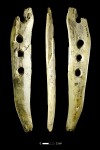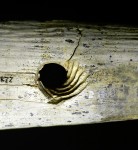 Archaeologists excavating the Hohle Fels Cave in the Swabian Jura of southwestern Germany have discovered a 40,000-year-old tool used to make rope. The piece was unearthed in August of last year by an international team led by Prof. Nicholas Conard of the University of Tübingen. Carved from mammoth ivory, the object is eight inches long and the wider side is dotted with four holes 7-9 millimeters in diameter. The holes are incised with deep spirals which are not decorative, but practical features that help thread plant fibers into strong rope.
Archaeologists excavating the Hohle Fels Cave in the Swabian Jura of southwestern Germany have discovered a 40,000-year-old tool used to make rope. The piece was unearthed in August of last year by an international team led by Prof. Nicholas Conard of the University of Tübingen. Carved from mammoth ivory, the object is eight inches long and the wider side is dotted with four holes 7-9 millimeters in diameter. The holes are incised with deep spirals which are not decorative, but practical features that help thread plant fibers into strong rope.
 Some of the most important Paleolithic artifacts in the world have been found in the Hohle Fels Cave, including the Venus of Schelklingen, the oldest known human figurative art, and the world’s oldest flutes. The recently discovered tool was found in the same layer of the cave as the Venus and flute, which is how it was dated to around 40,000 years ago.
Some of the most important Paleolithic artifacts in the world have been found in the Hohle Fels Cave, including the Venus of Schelklingen, the oldest known human figurative art, and the world’s oldest flutes. The recently discovered tool was found in the same layer of the cave as the Venus and flute, which is how it was dated to around 40,000 years ago.
 Rope or string prints have been found before in Paleolithic clay and there are some depictions of ropes in artwork from this period, but next to nothing is known about the process by which the first anatomically modern humans in Europe produced rope.
Rope or string prints have been found before in Paleolithic clay and there are some depictions of ropes in artwork from this period, but next to nothing is known about the process by which the first anatomically modern humans in Europe produced rope.
Similar finds in the past have usually been interpreted as shaft-straighteners, decorated artworks or even musical instruments.
Thanks to the exceptional preservation of the find and rigorous testing by the team in Liège, the researchers have demonstrated that the tool was used for making rope out of plant fibers available near Hohle Fels. “This tool answers the question of how rope was made in the Paleolithic”, says Veerle Rots, “a question that has puzzled scientists for decades.”
Excavators found the rope-making tool in archaeological horizon Va near the base of the Aurignacian deposits of the site. Like the famous female figurines and the flutes recovered from the Hohle Fels, the rope-making tool dates to about 40,000 years ago, the time when modern humans arrived in Europe. The discovery underlines the importance of fiber technology and the importance of rope and string for mobile hunters and gatherers trying to cope with challenges of life in the Ice Age.
Researchers from the University of Liège in Belgium demonstrate how the tool was used to make rope from green plants:
[youtube=https://www.youtube.com/watch?v=Z5B6ndWjKJg&w=430]
Researchers test the durability of the finished rope:
[youtube=https://www.youtube.com/watch?v=4WedyatF_zY&w=430]
The ivory tool went on display yesterday at the Blaubeuren Prehistoric Museum where the Hohle Fels Venus and three bone and ivory flutes are already on view to the public.
Just to Say that the vidéos are not working for me ( Europe/France ). Thanks anyway for the great photos ( as usual )
I may be from Barcelona or not, but I definitely know nothing about rope making.
For ancient rope making I would rather look at how tools are used in places like e.g. Papua under real ‘Stone Age’ circumstances.
My assumption is that the rope making steps presented here are mainly the braiding part, i.e just the final step. Before, however, fibers like nettle or hemp were extracted (the ‘unfibers’ removed), twisted and threaded together -maybe dried- and then the result drilled and braided.
—-
PS: Regarding those videos, the first one did work for me, but the 2nd one did not. I do assume, however, that maybe the latest Firefox versions with flash and flash blockers are the culprit, and therefore here to blame. I observed, however, some ‘hiccups’ before that previously were not there.
They don’t show us how the rope was finished off to stop it all unravelling. I was taught how to do that as a boy (we were a sailing family) but I can’t even remember the verb for it now. Whipping?
Anyway, is the problem recursive? Did we use a twine or string that was itself just a mini-rope? My patchy memory does not reveal the detail.
I do remember the solution when nylon lines appeared: we just melted the ends of the fibres together.
It’s a pity that the University’s press release doesn’t really tell us what the evidence is that proves that the item is a rope-making tool.
Must we assume that this was a product of modern man, or is it just conceivably the work of Neanderthals at 40k BP??
Out of jealousy at the richness of Roman finds in Spain:
https://www.southdowns.gov.uk/mysterious-prehistoric-farmers-and-missing-roman-road-revealed/
While the tool may very well be for rope making, I don’t think the scientists really know how to make rope properly.
The strands must be counter-twisted before they are brought together to actually form the rope.
This video shows a pretty good example, including the use of a similar tool:
https://www.youtube.com/watch?v=O_pjETZEe8U
I suppose they need good rope in Hervey Bay for their harpoons.
There is a National Geographic special of the rebuilding of an old rope bridge along an old Inka road in Peru. It show’s the women of the region making the rope from native grasses the same way they’ve been doing it for millennia. As the bridge needs replacing every few years, the tradition has never been lost there.
Very similar tools but I think they were made of wood? It’s been a good 15 years since I’ve seen it.
Sadly the old rope bridge has been bypassed by a modern one.
I grew up in a region of home built wire and rope suspension bridges referred to as “swinging bridges”. All were decked and some were designed to be wide enough to support cars and loaded trucks. When you crossed them they would all sway side to side, thus the nickname.
As kids we used to scare each other by waiting until someone was in the middle of the bridge, then start shaking the cables to get the thing to swing, trying to dump the unfortunate victim in the creek. Everyone got the treatment at least once.
The most interesting and practical use of them I witnessed was in eastern Kentucky. There would be one bridge for crossing the creek, and another that led out to a platform over the creek where the outhouse was set up. You could tell where the high water had gotten to in the last flood from how far up in the branches toilet paper fluttered in the bank side trees.
“This video does not exist”
Twice.